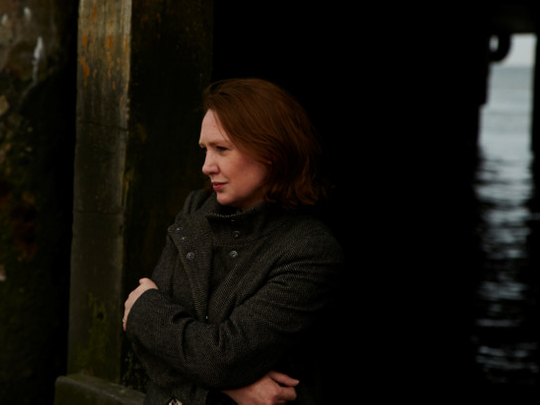
Looking back, it helped that Paula Hawkins wrote “The Girl on the Train” with growing urgency and dread verging on panic — because that feeling seeped into her novel. The book, she says, “felt like the last roll of the dice” for her as a writer.
It has been described as her debut — and it is her first under her real name — but in fact it is Hawkins’s fifth novel. Writing under a pseudonym, she had been commissioned to produce romantic fiction. But they never really felt like “her”, although you could see the way Hawkins was going. The first was quite lighthearted; by the fourth, they had got darker and darker.
“The last one has loads of terrible things happening in it and ended up being rather tragic in a lot of ways,” says Hawkins with a laugh. “Nobody bought it.”
She was, she says, “starting to panic. I don’t have a partner so I take care of the mortgage by myself and I was thinking, ‘Oh god, I’m going to have to sell the house, or find a new career.’ I was not in a good place but it was a real spur to get ‘The Girl on the Train’ right. I had to nail it and do it really well. It really concentrates the mind, that kind of thing. For the six months I was writing it, I didn’t really do anything else.”
In order to survive, she’d had to borrow money from her father. “It was really terrible, I felt really awful about it. You really don’t need your children borrowing from you at that point in life.” A small laugh. “I can pay him back now.”
“The Girl on the Train” has had a dizzying rise, and among all the so-called domestic noir books that are now excitedly talked about as the new “Gone Girls”, it may be the closest thing. Or at least the sales are (in fact, it is outpacing Gillian Flynn’s mega-seller). It has sold more than 120,000 copies in hardback since January, and sales of e-books and copies in other countries are at around 2 million.
The American market has taken to it especially — the book has been at the top of “The New York Times” bestseller list for 13 weeks, and the film rights have been bought by DreamWorks.
She must now be making an astonishing amount of money — more, she admits, than she ever thought she could make from writing. Has it changed her? “My life is exactly the same as it was before, although I’m aware that I’m more solvent,” she says. “I’m going to have some things done to my house which have been desperately needed. I may move and get myself a bigger place, but I haven’t gone crazy.”
Otherwise, nothing much has changed. Even successful writers are afforded anonymity, she points out, and nobody looks at us when we meet in a café near her home in South London, our conversation drowned out by the occasional passing police car.
You can see why the comparison is made and it isn’t just the “girl” in the title — not something that was dreamt up by her publisher, insists Hawkins; it was the working title of the book, long before she read “Gone Girl”. “‘The Woman on the Train’ just didn’t sound as good. I’ll take care next time not to have girl in the title.” And, she says, she knows the main character, thirtysomething Rachel, is “not a girl, but I do call people girls all the time — I refer to myself as a girl and I’m in my forties”.
Both books share the same sense of doom, the same killer details that make the reader feel as if the ground is shifting beneath them, and both of their unreliable narrators are flawed, unlikeable women with disastrous relationships. But the comparisons should really end there.
In “Gone Girl”, Amy is the supremely calculating architect of her story; in “The Girl on the Train”, Rachel staggers along, unsteady and unsure.
On her morning commute, the train always stops at the same signal and Rachel starts to become obsessed with the couple whose garden backs on to the train tracks. They have — in her fantasy — a perfect life, while Rachel is being sucked under by alcoholism and the heartbreak of her failed marriage.
But then she is shocked by something she sees in their garden one day and when, shortly afterwards, the woman goes missing, Rachel becomes entangled in their lives for real — only it’s complicated by the fact that she suffers from blackouts and memory loss, and is such a mess that nobody (the police, the woman’s husband, herself even) can trust her.
Hawkins joins a growing list of female psychological thriller writers being eagerly promoted by publishers hungry for the next Gillian Flynn.
Does she think women approach this genre differently? “It’s difficult to say. I certainly think there is this domestic noir trend, but there are plenty of men who write in that as well. I think perhaps women are less interested in spies and serial killers and are more interested — I certainly am — in everyday domestic dramas and real threats. Men tend to be attacked by strangers, women tend to be attacked by people they know.”
Most women, she points out, “are made to think about themselves in terms of what they should be doing to prevent violence happening to them”.
It is more than a straightforward crime thriller; at its dark heart are the threats, pressures and judgments made on women — from domestic violence to ageing, to how they approach motherhood. Although there is a murder — and I don’t think I’m giving anything away by saying the victim is female — it doesn’t feel like the gratuitous murders of attractive young women that pile up in so much crime fiction.
“I’m conscious of the fact that there are too many dead women,” says Hawkins when I bring this up. “It has become a cliché and I’m not really interested in thinking about that particularly, although I do watch that kind of stuff on telly.”
She says she found “The Fall”, the TV series in which beautiful young women are tortured and murdered by a ludicrously attractive serial killer, “really problematic — it was really interesting, but it did seem to glamorise it”.
Hawkins always wanted to be a writer of some kind. She describes an idyllic childhood in Zimbabwe — a big house with a swimming pool, a mother who stayed at home to look after her and a father who was a successful journalist and economics professor.
“I’m aware that it was an incredibly iniquitous society. I wasn’t conscious of that as a child, but by the time I was, things were changing and then I left when I was 17 anyway. I am aware that my very nice childhood came at a cost to other people.”
She wrote stories as a child — “quite fantastical”, she says, though she also attempted a few crime stories when she got into Agatha Christie as a young teenager. But she really wanted to become a journalist; because of her father’s job, other journalists often came to visit. Hawkins loved the stories told by foreign correspondents and decided this is what she wanted to do. It was a rather romantic view, she says with a laugh.
In reality, after moving to the UK when she was 17 and shortly afterwards going on to Oxford University, war zones had lost their appeal: “I’m way too much of a coward.”
Instead, she found herself working as a financial journalist. “I spent a lot of time writing about tax and pensions and mortgages,” she says, deadpan. Actually, it was pretty interesting; in the mid-1990s, she spent a lot of time writing about eastern Europe where the markets were opening up, then joined “The Times”, where she stayed until 2004. She went freelance, but in 2009, “after the market tanked, there wasn’t that much work around and the rates were terrible. I kind of thought, ‘Oh well, something will come up’. But it didn’t, really.”
Her agent got her a job writing what would be described as chick lit, under the name Amy Silver. Those books were great training, she says — “plotting and structure and pacing, all those things that apply across any genre”. The idea - “Rear Window-ish,” she calls it — of someone witnessing something from a train window, had been swimming about in her mind for a while.
She had started a different thriller with a woman with memory problems in it, but the book wasn’t really working out. By putting her on that train, it felt as if it could work. Hawkins plotted it out carefully — she’s not one of those writers who can start and see where it takes them, she says — and wrote the first half quickly. A bidding war was waged on her partial manuscript.
Hawkins seems a little dazed by its success. There have been tours, interviews and photographs. It’s not as bad as she thought, but “it’s not comfortable. I’m not naturally an extrovert. I’m a writer — I sit in a room by myself making things up. That is where I’m happiest.”
Her next book, another psychological thriller, about sisters set in northern England, should be out next summer. Does she feel under pressure to deliver another success? It is daunting, she admits.
“People have expectations, whereas they had none before. I’m very well aware that the kind of attention and success I’ve just had doesn’t come around very often and is highly unlikely to happen again, and it’s going to be hard and it might be really upsetting. I can’t really do anything about that now, I’ve just got to try and make this one the best book I can write.”
–Guardian News & Media Ltd
Box:
Masters of the game
Whether it’s lazy marketing or a genuine trend for unhappy, unreliable (and occasionally villainous) anti-heroines, a whole raft of books — many by first-time novelists — have been described as successors to Gillian Flynn’s bestseller.
“Disclaimer” by Renee Knight
Catherine Ravenscroft — successful, married, and a mother — is shocked when a novel appears on her bedside table. And even more shocked when she starts to read it only to realise that the story is about her, and something that happened 20 years ago.
“The Girl in the Red Coat” by Kate Hamer
In Kate Hamer’s debut novel, eight-year-old (a legitimate “girl”, then) Carmel is abducted by a man who claims to be her grandfather. Told from the point of view of a distraught mother, and her daughter, who is ensconced in a strange new life.
“The Liar’s Chair” by Rebecca Whitney
A toxic marriage, deeply unlikeable characters and dark secrets — basically, an excellent example of the genre by Brighton-based debut novelist Rebecca Whitney.
“The Silent Wife” by A.S.A. Harrison
We know the wife commits murder from the first page. A tense tale of an unravelling marriage, told from the husband and wife’s perspectives.
“The Daylight Marriage” by Heidi Pitlor
A forthcoming book by American writer and editor Heidi Pitlor, about a wife who vanishes from her suburban marriage. “I turned the pages with increasing dread,” says Stephen King of the book.








